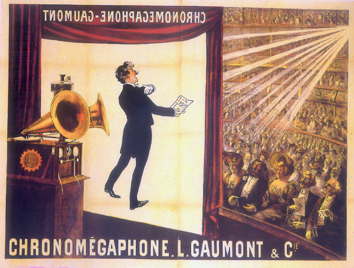Phonoscène on:
[Wikipedia]
[Google]
[Amazon]
 The Phonoscène was an antecedent of music videoKeazor, Henry and Wübbena, Thorsten (eds). "Introduction" to ''Rewind, Play, Fast Forward: The Past, Present and Future of the Music Video'', transcript Verlag (2010) and was regarded by
The Phonoscène was an antecedent of music videoKeazor, Henry and Wübbena, Thorsten (eds). "Introduction" to ''Rewind, Play, Fast Forward: The Past, Present and Future of the Music Video'', transcript Verlag (2010) and was regarded by
(text to be fully online on september 2013)
/ref>
{{DEFAULTSORT:Phonoscene Film sound production History of film Film and video technology Motion picture film formats
 The Phonoscène was an antecedent of music videoKeazor, Henry and Wübbena, Thorsten (eds). "Introduction" to ''Rewind, Play, Fast Forward: The Past, Present and Future of the Music Video'', transcript Verlag (2010) and was regarded by
The Phonoscène was an antecedent of music videoKeazor, Henry and Wübbena, Thorsten (eds). "Introduction" to ''Rewind, Play, Fast Forward: The Past, Present and Future of the Music Video'', transcript Verlag (2010) and was regarded by Michel Chion
Michel Chion (born 1947) is a French film theorist and composer of experimental music.
Life
Born in Creil, France, Chion teaches at several institutions in France and currently holds the post of Associate Professor at the University of Paris III ...
, Noël Burch Burch, Noël. ''La Lucarne de l’infini. Naissance du langage cinématographique'' Paris, Nathan, 1991, chapter 10, p. 226, 5th footnote (quotation: "en puissance, le premier long métrage «parlant» !" ("in power, the first feature "talking" film !") English version: ''Life to those shadows'' University of California Press, Berkeley, BFI Londres, 1990 and Richard Abel as a forerunner of sound film. The first Phonoscènes were presented by Léon Gaumont in 1902 in France. The first official presentation in the United Kingdom took place at Buckingham Palace
Buckingham Palace () is a London royal residence and the administrative headquarters of the monarch of the United Kingdom. Located in the City of Westminster, the palace is often at the centre of state occasions and royal hospitality. It ...
in 1907. Schmitt, Thomas. ''The Genealogy of Clip Culture'', in Henry Keazor and Thorsten Wübbena (eds.) ''Rewind, Play, Fast Forward: The Past, Present and Future of the Music Video'', transcript Verlag (2010), pp. 45 et seq., The last phonoscène was presented in 1917.
History
The Phonoscène was a forerunner of sound film. It combined a chronophone sound recording with a chronograph film shot with actors lip-synching to the sound recording. The recording and film were synchronized by a mechanism patented by Léon Gaumont in 1902. The first Phonoscènes were presented by Gaumont in 1902 in France.Introduction in London
Phonoscènes were presented atBuckingham Palace
Buckingham Palace () is a London royal residence and the administrative headquarters of the monarch of the United Kingdom. Located in the City of Westminster, the palace is often at the centre of state occasions and royal hospitality. It ...
on 4 April 1907 before Alexandra of Denmark, the Dowager Empress of Russia, the Prince and Princess of Wales and their children, The Princess Victoria, The Hon. Charlotte Knollys, General Sir Dighton Probyn, V.C., Mdlle. Ozeroff, The Hon. Sidney Greville
Sir Sidney Robert Greville (16 November 1866 – 12 June 1927) was a British civil servant and courtier who held several appointments in the Royal Households of the United Kingdom.
Greville was a younger son of George Greville, 4th Earl of W ...
( Royal Household of the United Kingdom), Colonel Blocklehurst and Colonel Frederick. The "singing pictures", as the British press called them, were projected on a screen over a bank of palms. The programme was a selection of phonoscènes previously presented at the London Hippodrome, as follows:
* ''The Miserere'' scene from '' Il Trovatore'',
* ''The Captain's song'' and chorus from '' H.M.S. Pinafore'',
*''Tit-Willow'' from '' The Mikado'',
*''This little Girl and That'', a song and dance from '' The Little Michus'', and
*''The Serenade'' from Charles Gounod's opera '' Faust''.
Belle Époque
The three major frenchBelle Époque
The Belle Époque or La Belle Époque (; French for "Beautiful Epoch") is a period of French and European history, usually considered to begin around 1871–1880 and to end with the outbreak of World War I in 1914. Occurring during the era ...
celebrities, Félix Mayol
Félix Mayol (18 November 1872 – 26 October 1941) was a French singer and entertainer.
Career
Mayol was born in Toulon, France. His parents, amateur singers and actors, arranged for Felix to make his debut stage at six years of age. In 1895, ...
, Dranem
Dranem (23 May 1869 – 13 October 1935) was a French comic singer, music hall, stage and film actor.
History
Born Armand Ménard, in Paris, he began working as an apprentice jeweler in a local shop before embarking on a career in entertainment ...
and Polin were recorded by Alice Guy-Blaché using the Chronophone Sound-on-disc system to make phonoscènes.
Last phonoscène to be projected and heard
''J'ai du Cinéma'' was the last presented phonoscène at the Gaumont Palace ("Greatest Cinema Theatre of the world") on 29 June 1917. Schmitt, Thomas, « Scènes primitives. Notes sur quelques genres comiques "hérités“ du café-concert », in ''1895 : revue de l’Association française de recherche sur l’histoire du cinéma (AFRHC)'',#61, 2010, p. 174(text to be fully online on september 2013)
/ref>
Notes
External links
{{DEFAULTSORT:Phonoscene Film sound production History of film Film and video technology Motion picture film formats